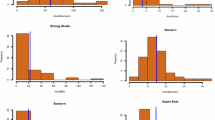Abstract
This paper studies the statistical law of fire attendance time and analyzes the correlation between fire attendance time and burned area based on the urban fire statistical data of Japan from 1995 to 2003 and in Jiangxi Province (China) from 2000 to 2010. The frequency of fire attendance time was better modeled by a lognormal distribution, and the probability density function for both Japan and China were formulated. The expectation of the lognormal distribution reflects the average level of fire attendance time. This study is the first to report that the distribution law of the burned area in each fire attendance time observes power function. And they are valid within 12 min of fire attendance time. The larger absolute value of the exponent of the power law function subjects to the larger probability of small-scale fire and the smaller probability of large-scale fire. It decreases as the fire attendance time increases. This indicates that the fire control ability becomes poor with longer fire attendance time.















Similar content being viewed by others
Abbreviations
- t a :
-
Fire attendance time (FAT), the difference between reach time and detection time in one sample of fire statistical data
- x c :
-
Lognormal distribution expectations
- w :
-
Coefficient of lognormal distribution
- R square (R 2):
-
Fitting relation coefficient
- A(t a):
-
Coefficient of the burned area distribution law
- B(t a):
-
Coefficient of the burned area distribution law
- X :
-
Discrete random variable of the burned area
- x i :
-
The possible values of X, i = 1, 2, 3……2,000
References
Bureau of Fire Protection (2008) Fire protection law of the People’s Republic of China. BFP, China
Badri MA, Mortagy AK, Alsayed CA (1998) A multi-objective model for locating fire stations. Eur J Oper Res 110(2):243–260. doi:10.1016/s0377-2217(97)00247-6
ReVelle CS, Eiselt HA (2005) Location analysis: a synthesis and survey: invited review. Eur J Oper Res 165:1–19. doi:10.1016/j.ejor.2003.11.032
Chuan-liang JIA, Hong CHI, Lei JI (2005) The allocation model of fire resource based on multistage fire protection process. Syst Eng 23:12–15
Ji-ping ZHU, Yong-hua GOU, Guang-xuan LIAO (2002) Optimal path of dispatch in urban fire fighting. Fire Saf Sci 11:201–205
Liu N, Huang B, Chandramouli M (2006) Optimal siting of fire stations using GIS and ANT algorithm. J Comput Civil Eng 20:361–369. doi: 10.1061/(ASCE)0887-3801(2006)20:5(361)
Jun W (2006) Study on the optimizing method and technique of fire station planning. Fire Sci Technol 25:100–102
Sardqvist S, Holmstedt G (2000) Correlation between firefighting operation and fire area: analysis of statistics. Fire Technol 36(2):109–130. doi:10.1023/A:1015450308130
Holborn PG, Nolan PF, Golt J (2004) An analysis of fire sizes, fire growth rates and times between events using data from fire investigations. Fire Saf J 39:481–524. doi:10.1016/j.firesaf.2004.05.002
Challands N (2010) The relationships between fire service response time and fire outcomes. Fire Technol 46:665–676. doi:10.1007/s10694-009-0111-y
Chen PENG, Ji-ping ZHU, Kohyu SATOH, Bing-hua LI (2010) Frequency distribution of the first response time of firefighting. Fire Saf Sci 19(1):33–37
Disaster Prevention Administrative Institute (2010) Handle book of Japan fire report. Tokyo Law, Tokyo
Malamud BD, Morein G, Turcotte DL (1998) Forest fires: an example of self-organized critical behavior. Science 281:1840–1842. doi:10.1126/science.281.5384.1840
Song W, Fan W, Wang B (2001) Self-organized critical of forest fire in China. Ecol Model 45(1):61–68. doi:10.1016/S0304-3800(01)00383-0
Ricotta C et al (1999) The flaming sandpile: self-organized criticality and wildfires. Ecol Model 119(1):73–77. doi:10.1016/S0304-3800(99)00057-5
Schenk K, Drossel B, Clar S, Schwabl F (2000) Finite-size effects in the self-organized critical forest-fire model. Eur Phys J B 15:177–185. doi:10.1007/s100510051113
Wang JH, Xie S, Sun JH (2010) Self-organized criticality judgment and extreme statistics analysis of major urban fires. Chin Sci Bull 56(6):567–572. doi:10.1007/s11434-010-4062-y
Weiguo S, Jian W, Kohyu S, Weicheng F (2006) Three types of power-law distribution of forest fire in Japan. Ecol Model 196:527–532. doi:10.1016/j.ecolmodel.2006.02.033
Weiguo S, Zheng HZ,Wang J, Ma J, Satoh W (2007) Weather-driven indicative of spatiotemporal power laws. Phys Rev E 016109-1–016109-5. doi:10.1103/PhysRevE.75.016109
Acknowledgments
The author would like to express their thanks to National Research Institute of Fire and Disaster of Japan and Fire Bureau of Jiangxi Province (China) for their support in carrying out all the fire data and the investigators who collected data. This work was sponsored by the National Natural Science Foundation of China under Grants No. 30972380, the Major Research Plan of the National Natural Science Foundation of China under Grants No. 91024027, the National Key Technology R&D Program of China under Grants No. 2011BAK07B01, and the Fundamental Research Funds for the Central Universities under Grants No. WK2320000010.
Author information
Authors and Affiliations
Corresponding author
Rights and permissions
About this article
Cite this article
Lu, L., Peng, C., Zhu, J. et al. Correlation Between Fire Attendance Time and Burned Area Based on Fire Statistical Data of Japan and China. Fire Technol 50, 851–872 (2014). https://doi.org/10.1007/s10694-012-0306-5
Received:
Accepted:
Published:
Issue Date:
DOI: https://doi.org/10.1007/s10694-012-0306-5






